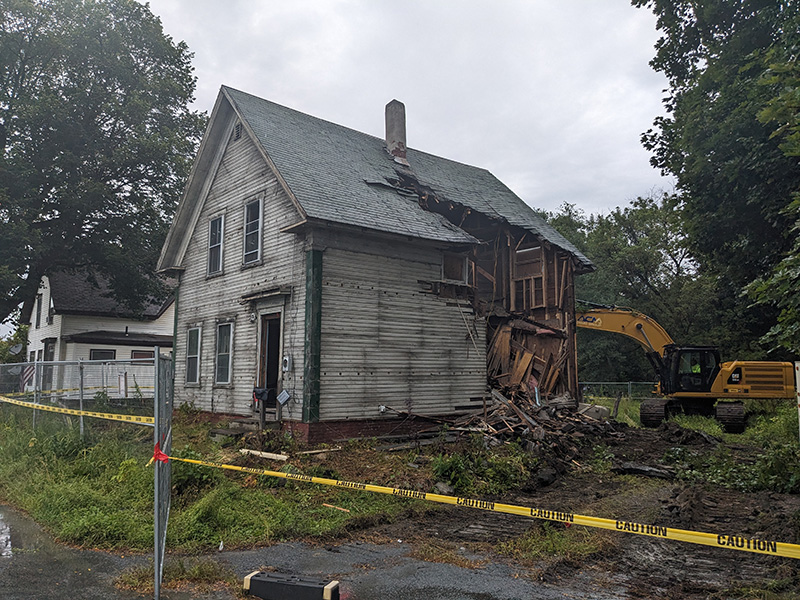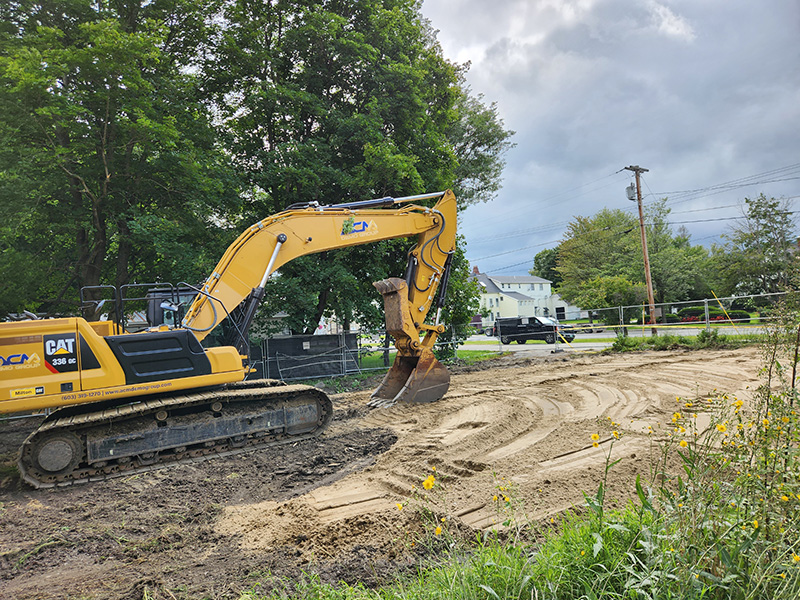
The redevelopment of brownfield sites is often associated with the revitalization of a property to bring it back into productive use, generate local tax revenue, and increase local employment. Redevelopment can also be part of a green or open space development, such as a riverwalk, park, or rail trail. Sometimes the conversion of a brownfield site into open space can be the catalyst required to help transform a neighborhood and spur economic development. In other cases, a brownfield site simply needs to be removed or cleaned up because it is a public nuisance and a blight on the neighborhood.
In the village of Woodsville within the town of Haverhill in northwestern New Hampshire, a derelict house along a former railroad corridor had been used for many years as a drug lab to manufacture and sell methamphetamines. The town fought to shut down the operation but was hampered by jurisdictional issues with law enforcement. Eventually, operations ended and the building lay dormant, obliging the town to take title. Now, what to do with the property?
When a community inherits a property with potential for legacy issues, the ability to sell it is often challenging. For many communities, this results in the parcel remaining abandoned and at risk for trespassers and arson. These risks put an additional burden on the community due to increased police and/or fire department presence.
For municipalities with limited financial resources, blighted properties like this can become a huge liability. For Woodsville, the presence of this blighted structure was a blot on the landscape and a barrier to redevelopment along Railroad St., which parallels Main St. and is highly visible.
Based on these factors, the town chose to demolish the building, but questions remained about the potential impacts to the site from the former drug manufacturing operations, which represented a barrier to the eventual sale of the property. Further complicating the matter, there were rumors of dangerous objects in the building and the possibility of an animal carcass buried in the yard. The town initially spent a significant sum to hire a contractor to decontaminate the building. Plus, there was a fuel tank in the dirt basement and indications of potential releases to the subsurface.

to remove a blight on the neighborhood.

To remedy the situation, the town pursued and secured funds from the New Hampshire Department of Environmental Services (NHDES) Brownfields Program to assess the site for hazardous building materials and demolish the building so the subsurface below the building could be accessed.
Using the NHDES funds, combined with additional funds from the US EPA Brownfield Program, our team developed a sampling plan which was approved by the EPA. Because the building occupied about half the lot and there were other materials dumped at the site, including an abandoned trailer, sequencing of the project was important.
A hazardous building materials inventory was conducted inside the building to evaluate the presence of asbestos-containing materials, lead-based paint, and other wastes that would require removal prior to demolition. Following that, the building was sealed and placed under negative air pressure while asbestos and other materials were abated by a licensed contractor. Once it was demonstrated there was no residual asbestos, the contractor removed remaining materials from the site and demolished the building, filling in and grading the basement to prevent a dangerous condition.
Following demolition and site restoration, we further evaluated the site for the potential of lingering impacts from the drug manufacturing operations, such as volatile organic compounds. We also conducted a ground penetrating radar survey to identify potential buried objects and retained a drilling subcontractor to advance soil borings through the former basement and other locations to evaluate potential impacts to soil. No impacts were found.
Oh, and the rumored animal carcass? We never found one.
Once completed, the clearing and removal of this abandoned property represented a tremendous win for the village and the town of Haverhill as a whole. By removing the blight and addressing public safety concerns, the town now has an asset that can be either sold for revenue or tied into a proposed nearby rail trail. Sometimes removing blight is the only catalyst that is needed.
George Naslas, PG, LSP, is a vice president with Weston & Sampson, Reading, Mass.
 (1).png)







